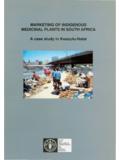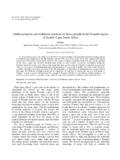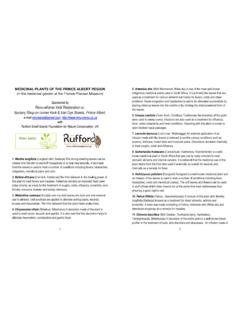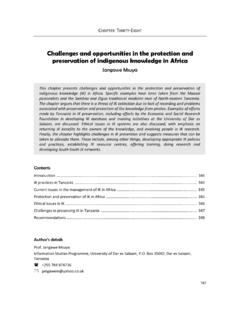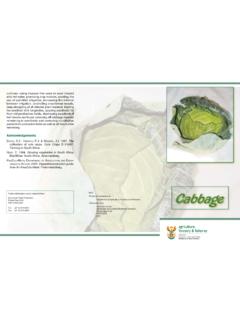Transcription of A review of plants used in divination in southern …
1 southern African Humanities Vol. 20 Pages 00 0 Pietermaritzburg December, 2008. A review of plants used in divination in southern africa and their psychoactive effects J. F. Sobiecki Department of Anthropology & Development Studies, University of Johannesburg, Box 524, Auckland Park, 2006 South africa ; ABSTRACT. Numerous indigenous healing traditions around the world employ plants with psychoactive effects to facilitate divination and other spiritual healing rituals. southern africa has often been considered to have relatively few psychoactive plant species of cultural importance, and little has been published on the subject. This paper reports on 85 species of plants that are used for divination by southern Bantu-speaking people. Of these, 39 species (45 %) have other reported psychoactive uses, and a number have established hallucinogenic activity.
2 These findings indicate that psychoactive plants have an important role in traditional healing practices in southern africa . KEY WORDS: divination , psychoactive, Shamanism, traditional healing, medicinal plants I eat medicines that work in my body like matches to dry wood. I do not open my eyes. It is not with my eyes that I see. My ancestors see for me. I see in a dream (the diviner Mahube to Kuper 1942: 167 8). Psychoactive or psychotropic substances are substances that, when ingested, affect the mind or mental processes. They can be defined as chemical substances that are used for the modification of emotional, intellectual and behavioural function in humans (Werry & Aman 1993). Practitioners of various magico-religious traditions around the world employ plants with psychoactive effects to facilitate spiritual healing (De Korne 1994; Harner 1973b.)
3 Schultes & Hofmann 1992). These plants are used in divination , sorcery and ancestor worship, and have even been considered as plant teachers (Luna 1984). The use of plants in divination has a long history. Use of the cactus Echinopsis pachanoi dates back 3000 years (Schultes & Hofmann 1992), while some hold that the visionary revelations of the Pythia, the divinatory priestesses of the Delphic Oracle, were stimulated by inhaling the psychoactive vapours of henbane, Hyoscyamus niger (Ratsch 1987). It has also been suggested that the Pythia, also called the Delphic Bees, would divine only after ingesting psychotropic meli chloron or green honey (Mayer 1995; Ott 1998). In societies where indigenous healing practices are common, there is a fundamental belief in the spirit world and its influence on the wellbeing of the individual.
4 In some of these societies altered states of consciousness (ASC) provide a means to gain access to the spirit world (which can be understood as the world of symbols and the unconscious). Psychoactive plants that produce ASC are considered great medicines (Schultes &. Hofmann 1992). Not much attention had been paid to the use of psychoactive plants in divination in southern africa . What reports exist are often marginal to other ethnobotanical enquiries. Indeed, an analysis of Liengme's (1983) survey of ethnobotanical research in South africa shows that the majority of studies of indigenous plant-use have focused on medicinal plants (16 %) and food plants (20 %), with only a few (7 %) relating to the category Magic, ritual and customs' (Dold & Cocks 1999). 1. 2 southern AFRICAN HUMANITIES, VOL. 20, 2008. Possible reasons for this lack of attention include researcher bias concerning substance use as part of spiritual healing practices (Winkelman & Dobkin de Rios 1989), an ethnobotanical focus on shamanic and hallucinatory plant use in the Americas (De Smet 1996), and an overlooking of more subtle psychoactive qualities of plants medicines.
5 An additional reason is the loss of orally transmitted plant-use information as people abandon traditional practices. Recently some researchers have embarked on revitalising the topic of psychoactive plant-use in southern africa (Mitchell & Hudson 2004; Sobiecki 2002). This paper aims to build on these works by investigating and documenting the use of psychoactive plants by Bantu-speaking diviners. southern Bantu diviners southern Bantu diviners ( Xhosa: amagqirha, Zulu: izangoma) are called to their profession by their ancestors. The verb ukuthwasa refers to this process of becoming a diviner, and the noun intwaso to the state or condition of the person undergoing the process (Hirst 1990: 89). The intwaso condition is characterised by a trouble'. (inkathazo) that involves various illnesses, copious dreams and psychiatric disturbances (Callaway 1868).
6 To become a diviner the initiate must first be cured of the intwaso condition. The treatment includes the use of special plant-based medicines of the home (Hammond- Tooke 1998: 12), dieting with ubulawu and training in techniques of divination and curing. The novice is apprenticed to a practising healer who teaches him or her the ways of indigenous healing. Ill-health and misfortune are believed to stem from ancestral wrath, witchcraft or ritual pollution (Hammond-Tooke 1998). It is the diviner's work to discover the cause of this misfortune and then to apply or recommend appropriate action, in the form of prescribing plant medicines or rituals. Shamans & southern Bantu diviners Because of differing worldviews, cultural practices and customs, I make the distinction between the vocations of the classical Asian shaman ( used here as a prototype) and the southern Bantu diviner.
7 However, the southern Bantu diviner shares with global shamanic healers the ability to utilise trance and altered states of consciousness (ASC), or what could be better described as enhanced states of association' (ESA), for healing purposes. Other similarities include communicating with spirits' (Boshier 1973: 282;. Junod 1962: 529; Kohler 1941; Schweitzer 1977: 98 9), undertaking soul journeys'. while dreaming or trancing (Hammond-Tooke 1998: 12; Kohler 1941; Lambrecht 1998: 153), and having animal spirit guides. Both types of practitioners also use psychoactive substances to facilitate dreaming (Lambrecht 1998) and to divine. During the fieldwork, no reports were obtained of San influence on the diviners' use of psychoactive plants or accompanying ASC. This is because the focus of my research is not on the cultural origins of the use of these plants , but on their uses, preparation and effects.
8 RESEARCH METHODS. This study is based on research that included interviews with indigenous healers, muti1. traders, muti users, and ethnobotanists, conducted mainly from late 1998 to 2003, and 1. from Zulu umuthi, pl. imithi = tree, plant, medicine, medicinal charm, wood. SOBIECKI: PLANT-USE IN divination 3. periodically until the present (see also Sobiecki 2002). Most of the fieldwork was conducted on the East Rand, Gauteng, South africa . The fieldwork comprised semi- structured interviews with 19 practising indigenous healers (ten female and nine male). at their muti shops or homes. Fourteen of the healers are diviners, while five are herbalists who do not divine. Most were interviewed in the Witwatersrand urban area; some interviews took place in the Free State and KwaZulu-Natal. I traced the healers through word of mouth or through telephone directories.
9 I established a close relationship with four of the healers and continue to discuss issues with them today. I also held informal interviews with approximately 30 other people, including muti traders, muti customers, academics and other ethnobotanists. Most of the healers I encountered could communicate in English. Of interest is that almost all, whatever their ethnic group (Tsonga, Sotho, Xhosa or Indian), were accustomed to selling their medicines using Zulu vernacular names. This convention assisted with the cross-checking and confirmation of plant identifications and uses. Where possible, identifications were confirmed by showing colour photographs or pictures of plants to the healers, using colloquial names and plant name lists (Williams et al. 2001; Williams 2007). I also studied and compared live specimens with other voucher specimens and identification information in the botanical literature.
10 I deposited voucher speciments in the Moss Herbarium at the University of the Witwatersrand, Johannesburg. My research yielded a list of 85 plants used for divinatory purposes, that is, during initiation, to enhance intuitive abilities, to promote dreaming and induce trance (Appendix 1). The plants are believed to be crucial to the development of special healing powers. The majority are administered internally. Of the 85 species, 39 (45 %) are known to have psychoactive properties (Sobiecki 2002). Appendix 2 lists plants used in non-divinatory healing, but which nevertheless have interesting psychoactive effects. Indigenous terminology for psychoactive plants Some interesting terms for psychoactive plants exist, including bhayiskhobho (bioscope (cinema) in Zulu), otherwise known as the mirror' or TV', which refers to the effects of hallucinogenic plants such as the toxic Boophone disticha ( ) Herb.

